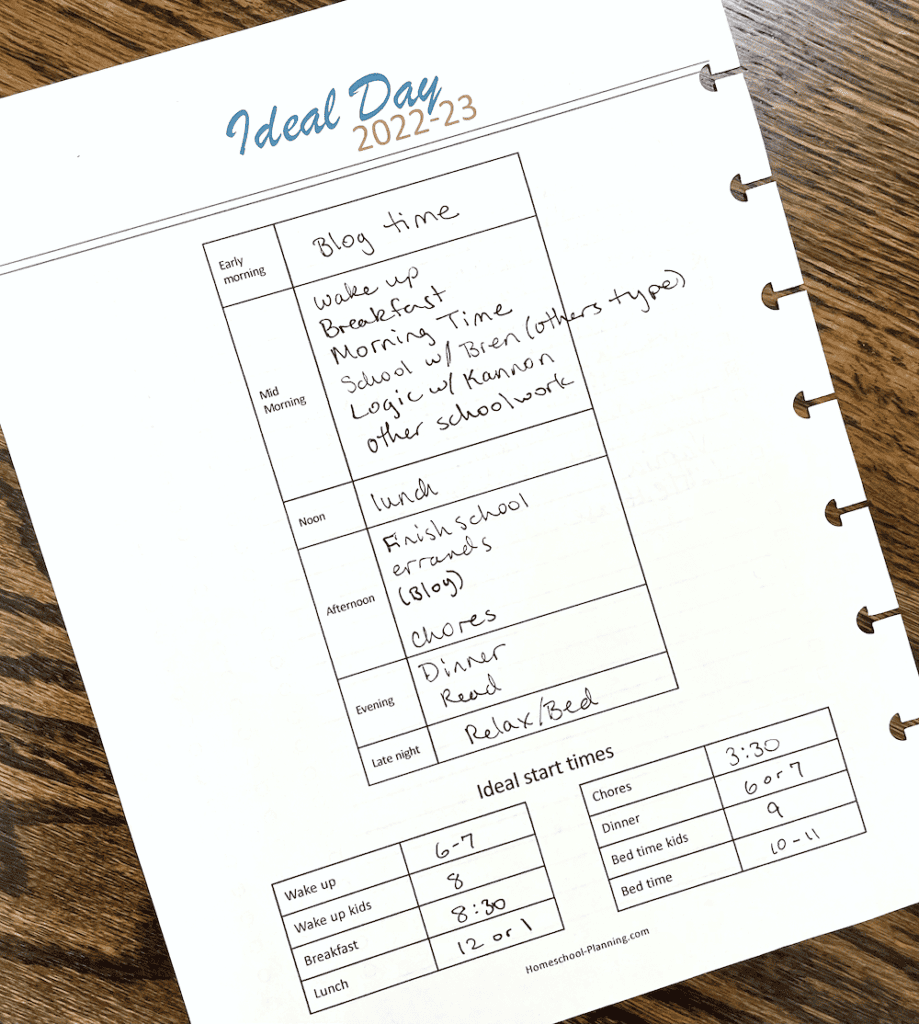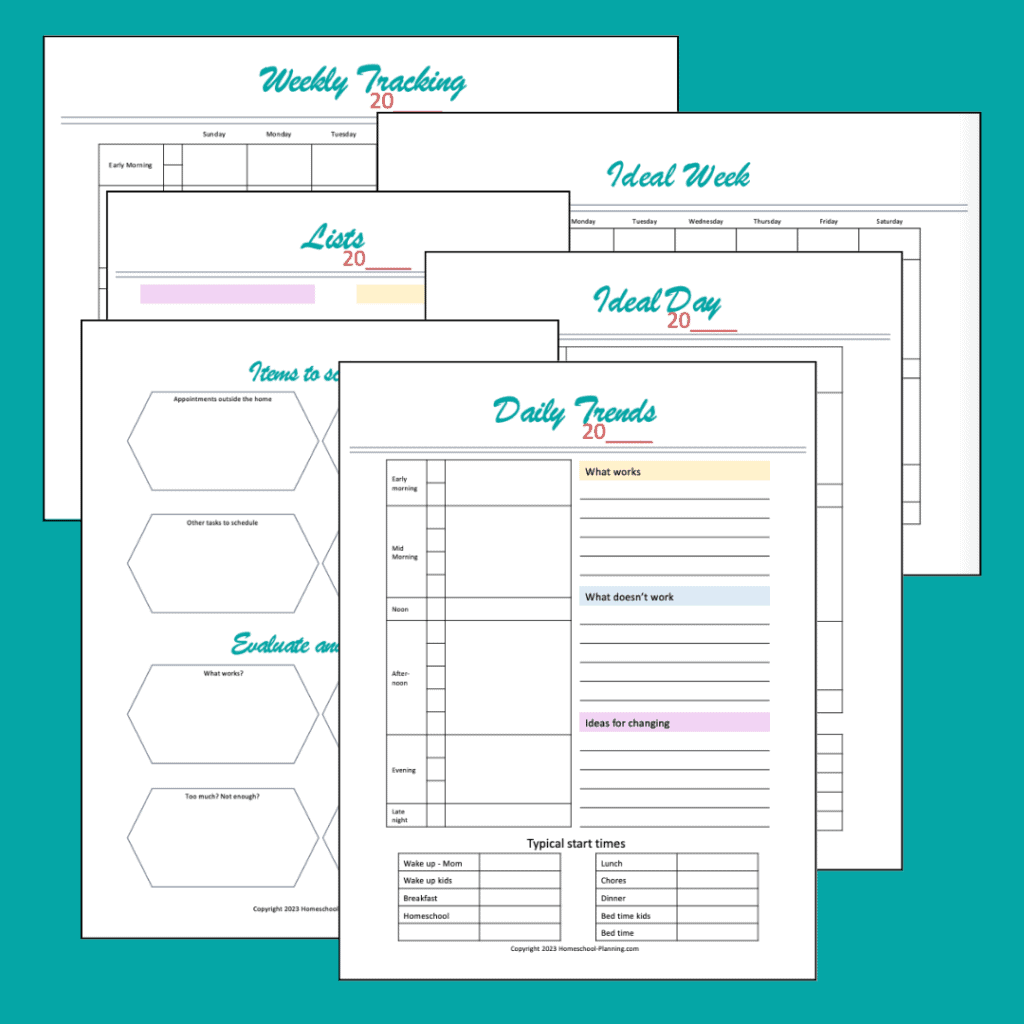Many homeschoolers don’t use too much of a daily homeschool schedule in their day, but it can be helpful. If you are wondering how to go about creating a daily schedule that works for you and your family, you have come to the right place!
In this article, I will discuss my best tips for creating a daily homeschool schedule that works.
Keep reading to find out more!

What is a daily homeschool schedule?
A daily homeschool schedule is a general framework for your day. It holds the specific tasks you plan to do each day and in what order. Some will keep their schedule loose and flexible, while others will plan to the minute.
While a schedule is technically something that is strict and associated strongly with time limits, the term is often used in place of other terms like routine or rhythm. These terms are usually less associated with time, but focus more on order and flow.
Read: Schedules, Routines, and Rhythms: Which is for me?
In this post, I will use it more in a general sense as a reference to your daily plans and guidelines and will often interchange it with other more flexible terms.
You are the expert on your family, so I will leave it to you to choose how flexible you want your daily schedule. Whether it is a schedule to the minute or just an order of tasks.
Ultimately, your daily schedule is what you decide it to be for your day, no matter what you call it. It should give you the boundaries and plans for your day in a way that helps you accomplish your tasks without feeling too restrictive.
Why do I need a daily homeschool schedule?
Creating your daily homeschool schedule will help you include a framework in your day. It will reduce decision fatigue and help you to accomplish your goals for the day.
When you plan out your ideal schedule in advance and put it into action, you teach your kids good habits of managing their day well. The predictability of a general schedule – even a flexible one – helps reduce stress for you and your kids.
This small step of creating a rhythm for your day will help bring order to the chaos that is life.

How to create a daily homeschool schedule
Working out a homeschooling daily schedule for your family can be daunting. But setting yourself up for a smooth day with your kids will help you get on the road to success.
Be sure to download my free printables to help you through the process of setting up your daily schedule. These free printables will be a tool you can reference all year anytime you feel off track.
Here are my 10 best tips for creating a daily homeschool schedule from start to finish.
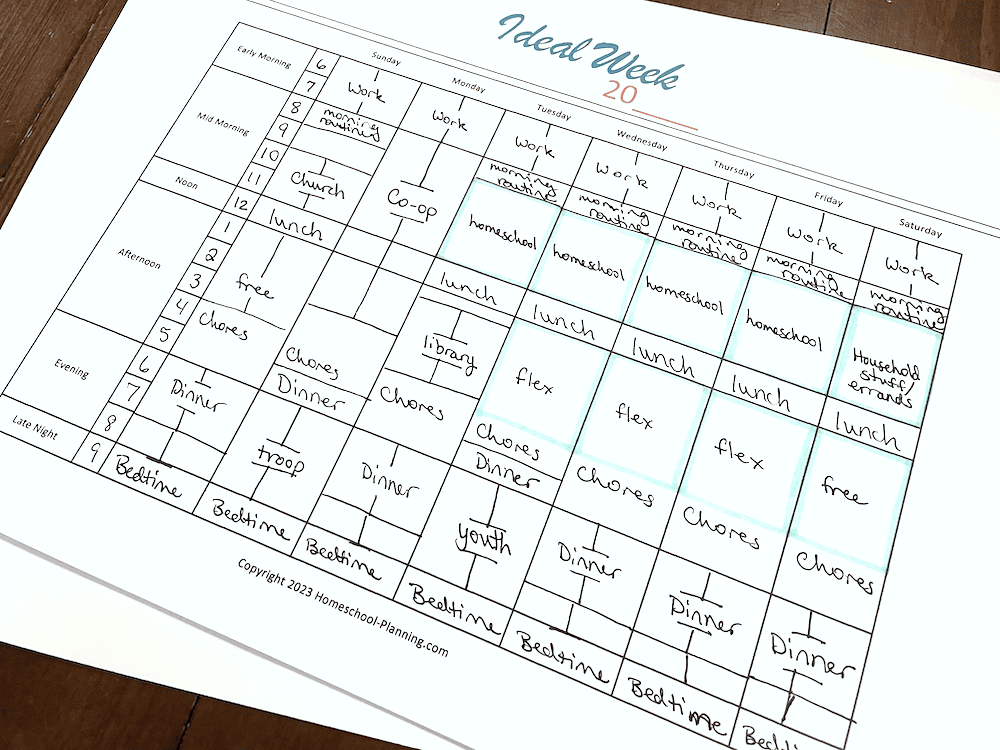
1. Start with your weekly framework
When creating a more detailed daily homeschool schedule, I like to begin with a weekly framework. This is just a general overview of what we would do in a typical week.
I start by looking at all our weekly appointments as well as any normal routines we have. Then I plan our homeschool time within the day and plan out ideas for all the extra things.
As I look at the trends of our typical week, I can then use that as a basis for creating our typical daily schedule.
For more on creating a weekly framework, check out my post about planning your weekly homeschool schedule here.

2. Find your natural rhythm
A good tool to help you build out a workable daily homeschool schedule is to find your natural rhythm to your day. Observe how you already go about your day and capture that on paper to help set a basis for a daily rhythm you can work with and adjust as needed.
Create new routines you can fit into your established habits and make small changes until your daily schedule includes what you need.
Start with your natural inclinations and adjust here and there. This will allow you to build something that will stick over time and gives you the ability to customize it to your needs.
If you’d like to learn more about using your natural rhythms to build out your daily homeschool schedule, check out my post about finding your natural daily rhythm here.

3. Consider your energy
Are there times within your day when you think more clearly? Most of us have times when we like to get up and get things done and others when we lounge around. Take note of these times and capitalize on them.
Perhaps you are early risers at your house and like to knock out work quickly. Maybe your daughter is a night owl like mine and works really hard in the evenings.
It’s helpful to pay attention to the times in your day when you and your kids have the most energy for learning. These are the times when schooling will be the least difficult.
School doesn’t have to be first thing in the morning.
You or your kids may have other obligations that also require energy and learning. Aligning all your tasks with appropriate times of energy and focus when possible could guide your daily schedule.
Homeschooling can happen at any point in the day, any day of the week. And learning when those times of energy are within your day will benefit you and your kids.
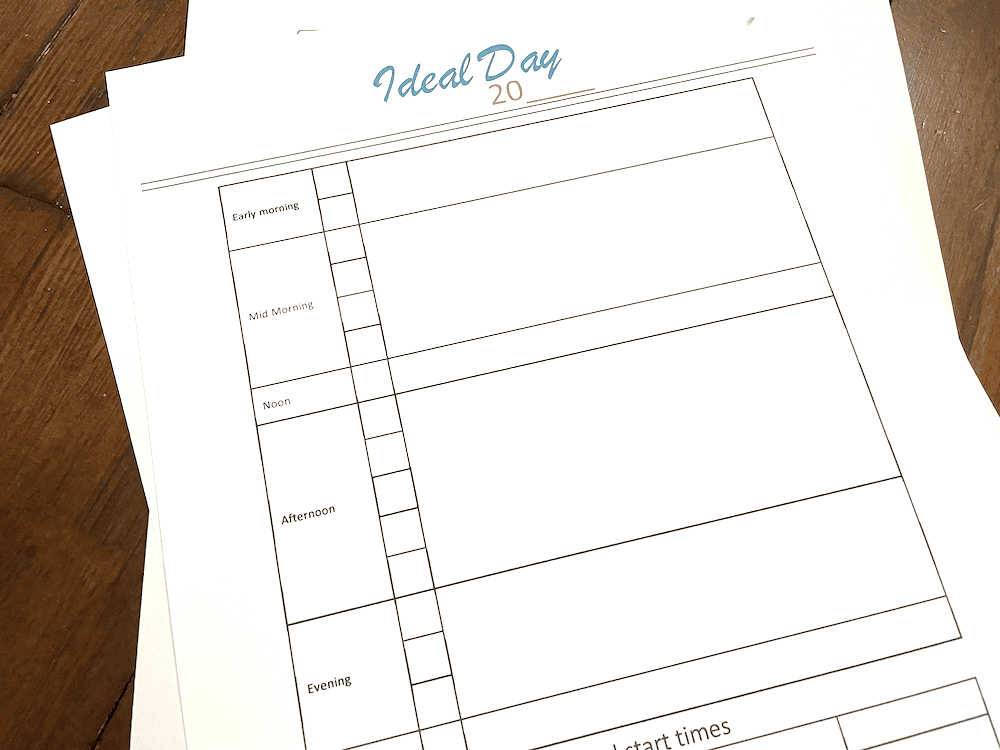
4. Create an ideal day
We all know that every day is different. It’s impossible to create a daily homeschool schedule that you will stick to each and every day perfectly, but having a goal to strive for will often bring you close.
So instead of creating a perfect schedule that you are tied to everyday, create a general approximation for what your ideal day may look like. Keep it realistic and though you will rarely accomplish your ideal fully, you will be closer with the goal.
If the whole family woke up refreshed and everything worked well, what would your ideal homeschool day look like? This is what we’re going for.
Of course, you do need to keep it realistic. We all still need to eat, and math won’t always come easily. So leave some room in there for things to not go perfectly. But create a base plan.
If you have already mapped out your typical daily rhythm and found the general trends for your day, then the hardest part is done. But let’s take it one step further.
Is your natural rhythm accomplishing what you want it to already? I’m guessing not, since you’re reading this article. You feel the need for something more.
Make small changes
So creating your ideal day is to make some small changes to what you already do so you can take it to that next level. That is where we’re trying to go.
My middle daughter is a night owl and usually sleeps in when she can. Now I could continue to allow her to do that or I could have her get up a little earlier so we can get a good start to our school day together. Either way will work, but pulling her into our family’s rhythm more will benefit us all.
Some days cooking really is not what I want to do. So my natural leanings are to procrastinate as long as possible on cooking dinner. Sometimes this means we don’t eat till 8. It works for us most of the time. But is that my ideal? No, I’d prefer to get my act together and get dinner together a little earlier.
You may feel like your days are all so different that creating one ideal day will never work. That’s ok, you can map out your entire ideal week if that works better for you! This can also allow for some nice little hacks we’ll get to in a bit like looping or blocking your schedule.
Read: How to plan your weekly homeschool schedule
You also might prefer to do multiple versions. A version for you and a version for your kids. Or a version for when dad is home and a version for when he’s at work. However you want to map out your ideal day or week is great, just get it created. This is your guide.
Start now with a general approximation and as you work through the rest of these tips, tweak it. By the end, you hopefully will have a great daily homeschool schedule ready to go.

5. Block your day
Time blocking is a hugely popular time management practice these days. This is when you schedule every block of time in your day and assign a task (and only one task) to that time period. And while I think it can be helpful, I suggest a slightly different take on time blocking for your homeschool day.
This different spin is to schedule in larger chunks of time for larger practices. Like a block of time for your morning routine and a block for homeschooling. It can be valuable to create routines to use during each block, but keeping the smaller tasks not bound by time can give greater flexibility to your day.
For instance, you might assign a block of time for math, followed by writing, then science. If math takes less time than usual one day, you either end up ahead of schedule or with unused time. If it takes longer than normal, you must either leave things undone or be behind schedule.
Why put this stress on yourself?
If you use a larger time block for homeschooling in general, each subject can easily flex within this time period. It gives a good framework for your day without being too stifling. And let’s face it, kids don’t always do what we want within a given 15-minute time period.
Within this time block, you can use a routine or encourage your children to come up with their own routines, which is basically just an order or flow for what you do within that time. This helps allow some good independence and control as they are able.
You also are able to easily decide what homeschooling looks like each day. A field trip may easily replace your normal homeschool routine.
Here are a few other reasons why larger block scheduling can be helpful:
- Every child doesn’t need to do certain subjects at the same time
- Kids do well with a little control
- Flexibility is key
- Things not left undone
- Not “behind” schedule
- Less unused time
- Allows for interruptions
- Give everything the time it requires
- Kids don’t always run well on our tight schedules
- Can help with task transitions
Here are a few ideas of larger time blocks you may want to include in your day:
- homeschool
- work
- chores
- rest
- morning routine (get ready for the day)
- bedtime routine
- free time
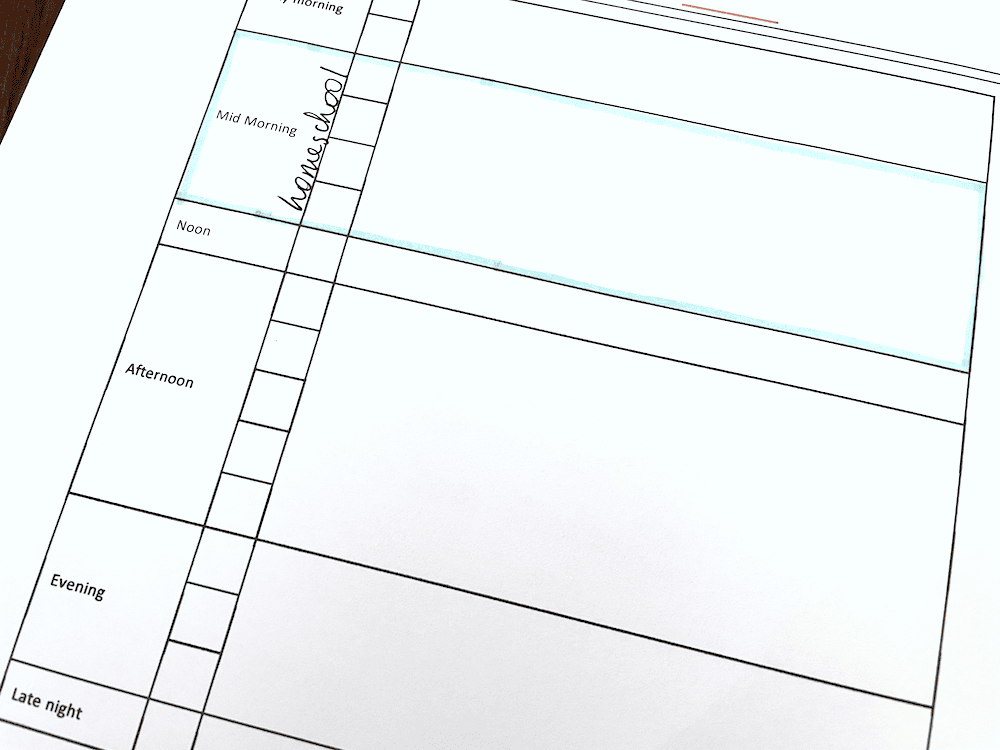
6. Input priorities first
Inputting priorities first in your schedule will help make the important things happen. Make homeschooling your priority in your day and other things can be planned around it. Make sure your children get what they need first.
Something I find myself saying a lot in our house is, “Do the things you have to do so you can do the things you want to do.” I’m sure someone important said it better before me, but I couldn’t tell you who that is.
When homeschooling is your priority, it should be the main focus of your day. If nothing else happens and all you end up doing is helping your kids to learn, then your main priority has been met. It shouldn’t be an afterthought.
I understand that isn’t always possible for every family. If you work and also homeschool, work may need to be your priority. Because food. But somehow, homeschooling still needs to be a top priority however possible.
You may not be able to plan your homeschool hours and fit everything else around that. Instead, you may need to plan your work hours and schedule homeschooling around that. That is fine as long as it is still priority. It will be difficult to do both, but not impossible.
In this case, try to think outside of the typical box of “school hours”. If you work during the day, homeschooling can be done in the evening or on weekends. Your older kids could do some independent work while you are gone, and you could check it when you get home.

7. Choose start time goals
Though I typically hold to a loose and flexible daily homeschool schedule, I have found it helpful to choose start time goals for the big tasks in our day. For the blocks of time for our daily routines like school, chores, and bedtime.
I keep them as goals and guidelines so our day has some structure, but it’s no biggie if we don’t quite meet those times. This is how it stays flexible, allowing for overflow when needed.
The start time could be something like 9 am. Or you could use a range, like 9-9:30 am.
These times shouldn’t be arbitrary or forced from someone else’s schedule. Using general time frames from what your day is already like is perfectly fine! In fact, using your natural daily rhythm as a starting point is a great way to frame your day.
But I do encourage a little commitment to a time frame, just so your day doesn’t get away from you. Whether you are a highly structured person or only like a little routine, choosing start time goals will help you keep the day moving on.
You could choose start time goals for tasks and routines like:
- Wakeup
- Morning routine (get dressed, make bed, etc.)
- Chores
- Homeschool time
- Morning Time in your homeschool
- Meals
- Naptime
- Bedtime routine (brush teeth, etc.)
- Bedtime
- Any other part of your day

8. Get detailed
At this point in creating your daily homeschool schedule, you get to dive into the details within each block of time. And you can decide how specific or loose you’d like to keep it. If desired, you could add more specific times for each task or keep a general routine for each block. Start times can be your general guide.
I like to set some routines to guide what we do. For instance, we have a general morning routine. This helps my kids remember to do things like brush their teeth and make their bed. For young kids, you could make a chart with pictures, while older kids can use a list. You could do the same as a reference for an evening routine.
Here’s an example of a basic morning routine:
- 8:00 Wake up
- Make bed
- Brush teeth/hair
- Get dressed
- Eat breakfast
Setting up your homeschool routine is another important step. When thinking about your daily homeschooling schedule, you might want to think about what you will do together with all of your kids and what they will do separate. Also what they can do more independently or. with you.
Read: Design your perfect daily homeschool schedule in 10 steps
Consider which subjects you will be doing each day. You may not want to do every subject every day. Or you may want to do some subjects every day and others only once or twice a week. Or rotate subjects. There are so many options.
For a couple years, I decided to block our science for the whole week into one day. We did everything else 4 days and week and then once a week we would do science. This way I felt I could get to the messy science experiments easily. All the mess was on one day.
Another approach you could consider is to loop subjects. You make a list of subjects you want to do, but instead of making sure to do them all each day, you do what you can get to within the time frame. The next day you start on the list where you left off, then loop back around to the beginning and go through the list again until time is up.
Looping can also be done with other things, like daily chores. Rather than choosing a chore for Monday, a chore for Tuesday, and so forth, you have a list of chores. Each day you do one from the list, looping through the list. This way if you miss a day, that chore doesn’t get left undone. You will just do it the following day.
In the end, you can get specific with what is done each day or you can keep it loose. Having at least a general plan with routines included will help you accomplish things. And specific times can be used or not.

9. Make it flexible
No matter how in-depth you make your daily homeschool schedule, you should be sure to keep it flexible. I have found the more specific you make a schedule and attached to times, the less flexible it becomes. So keep those start times as guidelines but not hard rules.
So what do you do when the toddler vomits all over the floor? Or your mom stops by for a quick visit in the middle of homeschool time?
If you leave a little margin and white space in your day, this extra time can soak up the overflow in your day. Pad all the time blocks within your day. Think of how long it may take then add more.
Filling only 75% of your day with activities will help with the overflow and unexpected. The other 25% will be your margin. This is 45 minutes out of every hour. Three hours out of 4.
It may be hard for you to only schedule 3/4 of your time. If so, consider the extra time a rest period. Rest is also important.
Keeping your schedule loose will allow for unexpected times. You may need this more when your kids are little. But you’d be surprised how the emotions of older kids can affect their days. And yours for that matter!
There is nothing wrong with keeping your day simple and flexible. Having a peaceful calm home will make homeschooling your kids so much nicer.
If you’d like more ideas for ways to keep your homeschool schedule flexible, check out my post about how to have a flexible homeschool schedule here.

10. Try it for a week then adjust
Once you feel like your daily homeschool schedule is how you want it, go ahead and put your new day into motion. Try it for a week and adjust things as needed.
I find it helpful to start slow with a new routine. If you are changing several things in your day, start by adding only one or two changes, waiting for that adjustment to happen before you change anything else.
For instance, if you plan on adjusting your wakeup times when school starts, you might want to begin a week before you start school, and get up earlier without any other changes to your day. Allow everyone to adjust to the new sleep times for a few days before starting homeschool or other routines.
You can phase in new changes, see how it goes, then proceed.
I do suggest you try new things out for at least a week before you scrap them. Sometimes it can take even longer. But trust your gut. If something just doesn’t seem right, adjust until it does.
Start slow, try it for a week, then adjust how you feel it’s needed.
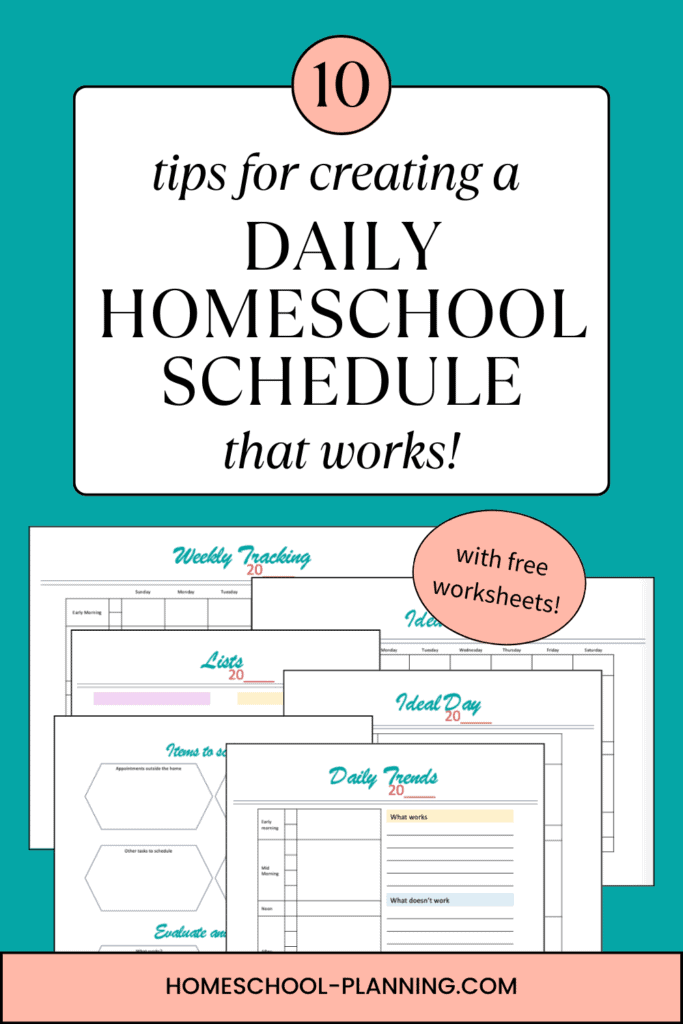
Sample daily homeschool schedule
Over the years I have homeschooled, I have created many homeschool daily schedules. I have included a few below. Some are simple, and some are more detailed. The season of life dictates this. Some years time is slow, free, and flexible. Other years, more structure is needed. Every season of life has different needs, and your daily schedule will reflect that.
Daily homeschool schedule template
Creating your personalized daily homeschool schedule is easy with these FREE worksheets!
Create a flow for your day and week, making the necessary time for what is important: homeschooling your children.
Yes, these are the same worksheets you’ve seen in pictures throughout this post.
Take a huge step toward getting your homeschool days running smoothly and download your free daily homeschool schedule printable today!
Daily homeschool schedule
Creating your daily homeschool schedule isn’t always as easy as just plugging in times and tasks to your day. To be successful in creating a rhythm for your day, you must look at the big picture. Create an ideal daily schedule as a goal and block your day into chunks, keeping priorities first.
If you also aim for a flexible schedule, you’ll be more apt to stick with it. There are a lot of things to consider when creating your daily homeschool schedule but having a smooth homeschool day is worth striving for!
Related Posts
How to plan your annual homeschool attendance










